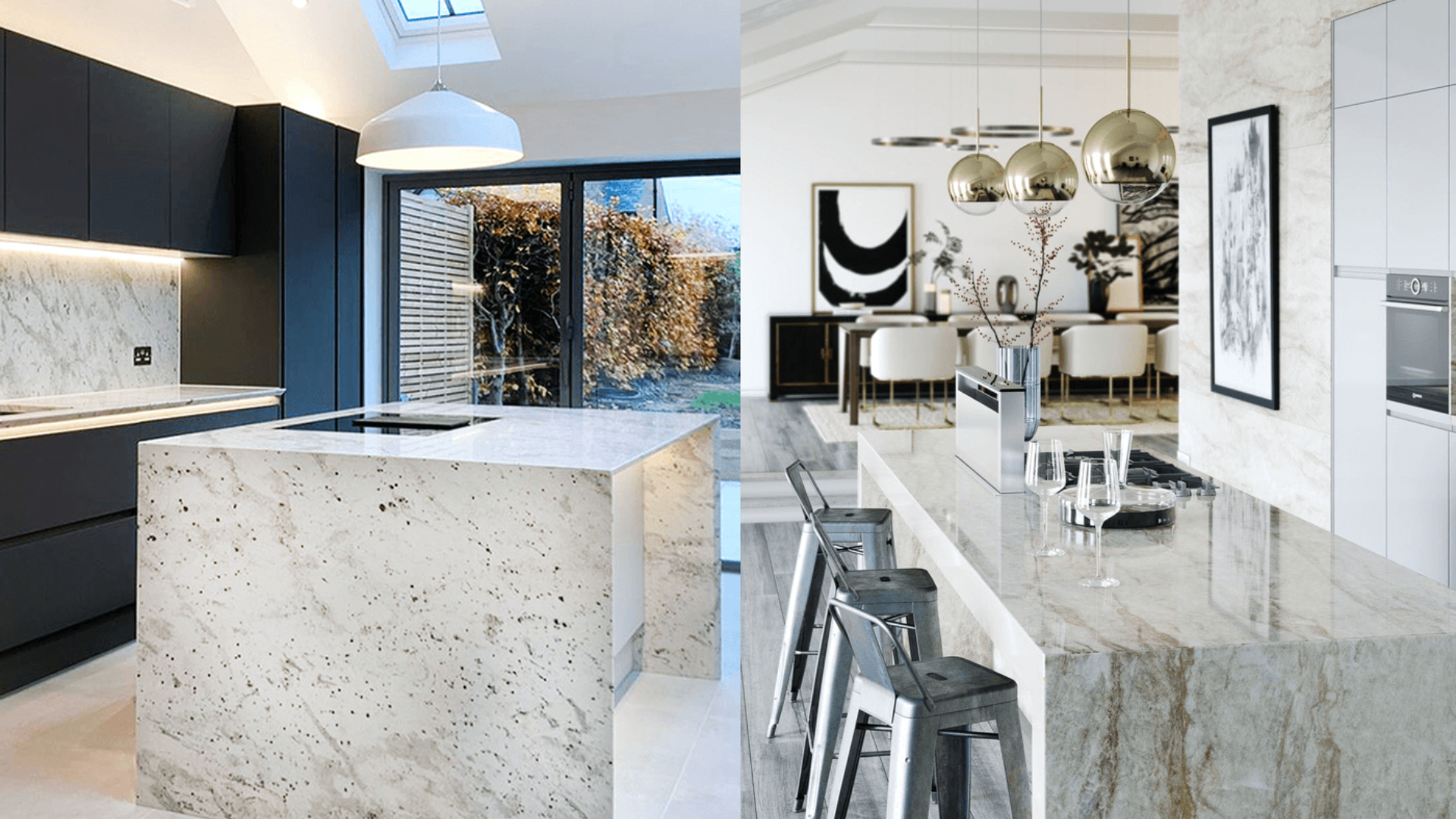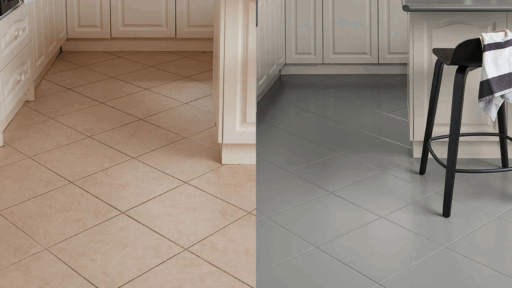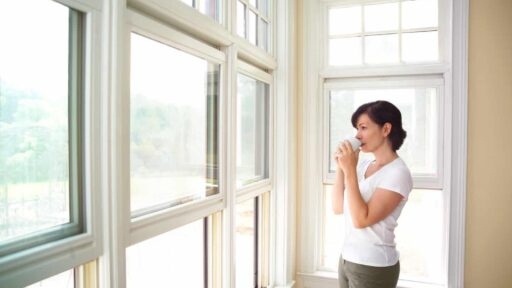Choosing the right stone for your kitchen, bathroom, or flooring can be confusing.
There are many options, but two of the most popular are quartzite and granite.
They both look beautiful, feel strong, and last a long time. But how do they really compare? This blog breaks it down in simple words, with clear differences and helpful advice.
As someone who has helped friends pick stones for their homes and even made a few choices myself, I understand the questions that pop up.
Is quartzite stronger? Is granite easier to care for? What about the price? Or stains?
I’ll walk you through everything, so you can make a smart choice that fits your needs, style, and budget.
What Is Quartzite?
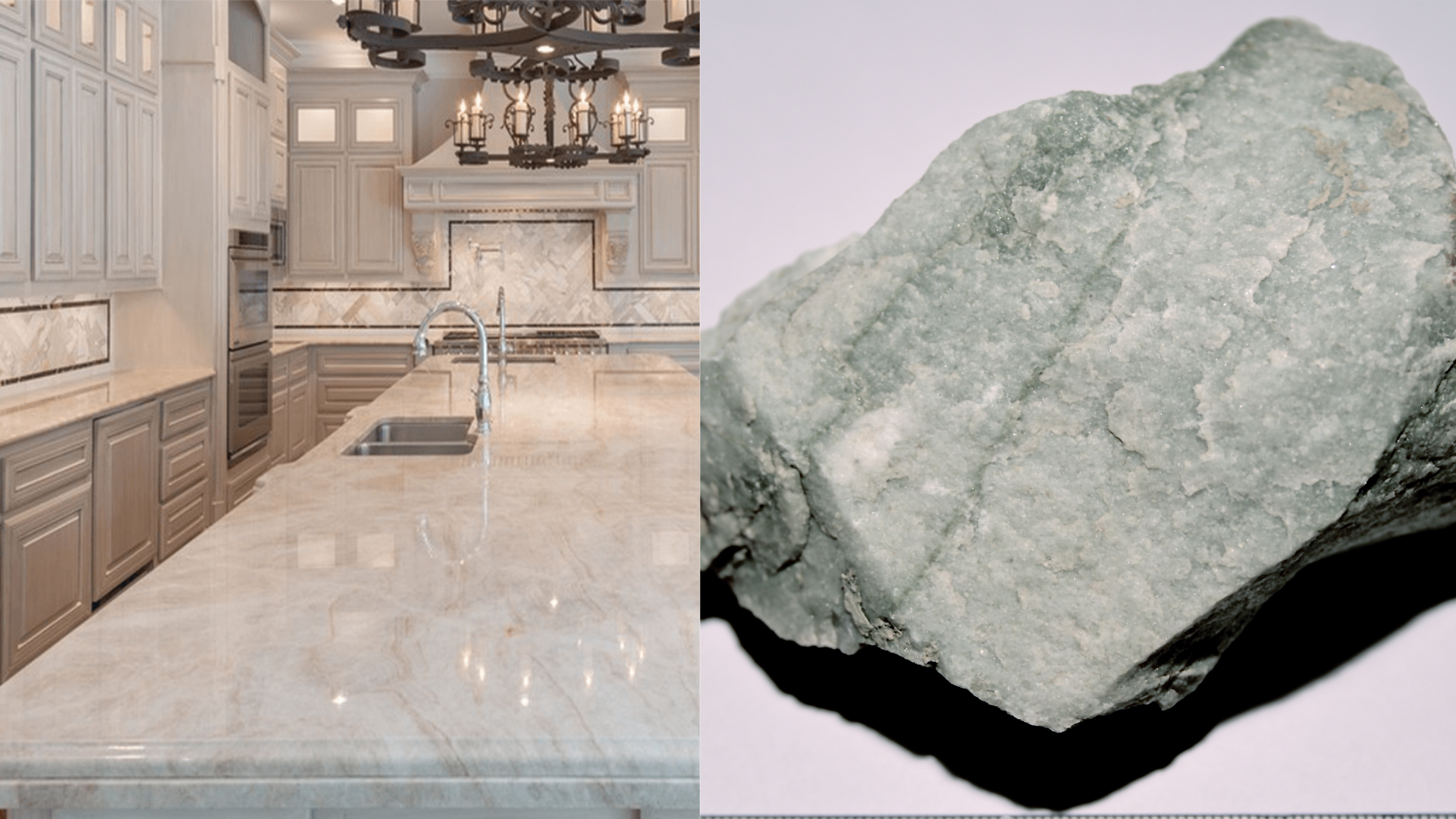
Quartzite is a natural stone that forms when sandstone is squeezed and heated deep underground. This process makes it much harder and more durable.
It’s cut into slabs like marble or granite and used in homes for countertops, backsplashes, walls, and floors. Quartzite resembles marble but is stronger and less fragile.
It often comes in whites, grays, soft pinks, or blues, with unique patterns in every piece. Some are shiny and smooth, while others have a more natural texture.
People love quartzite for its clean, timeless look. It brightens up kitchens and bathrooms, adding a touch of style without being high-maintenance.
If you like the look of marble but need something more durable, quartzite is a great alternative.
What Is Granite?

Granite is a natural stone formed when molten rock cools slowly deep underground. This makes it very hard and durable.
Like quartzite, it’s cut into slabs and used for countertops, floors, and more. Granite has a grainy look with specks of black, white, red, green, or blue.
Some slabs are bold and colorful, while others are more subtle. Each one is unique, adding a personal touch to any room.
Granite is popular because it’s strong, heat-resistant, and durable enough to withstand daily use. It works well in both modern and traditional spaces.
It’s great for kitchens, bathrooms, outdoor areas, and even fireplaces. The colors and patterns stay bright over time.
If you’re looking for something tough, natural, and full of character, granite is a great choice.
Granite vs Quartzite: What’s the Difference?
Granite and quartzite are both natural stones that bring strength and beauty to any space. But they differ in look, care, and long-term performance. Below is a simple breakdown to help you decide which one fits your needs best:
1. Appearance
Choosing between quartzite and granite often comes down to the kind of look you want in your space. Here’s how they compare in style and overall feel:
Quartzite
Quartzite has a soft, elegant look that’s often compared to marble.
It usually comes in light colors, such as white, gray, or pale blue, with long, flowing patterns that evoke a sense of calm and cleanliness.
I love how it adds brightness to a room without being too loud. Some slabs even have a gentle shimmer that catches the light just right.
Granite
Granite brings bold character and strong texture. It comes in a wide range of colors, from deep blacks to rich reds and greens.
I’ve seen kitchens completely transformed by a dramatic granite slab. Its grainy, speckled patterns give a grounded, cozy feel that works great in both traditional and rustic spaces.
If you want soft and airy, quartzite may be best. For bold and earthy, granite might be your pick.
2. Durability
Quartzite and granite are both strong natural stones, but they hold up a little differently. Here’s how they compare when it comes to toughness and daily wear:
Quartzite
Quartzite is one of the hardest stones you can get. It ranks higher than granite on the Mohs scale, meaning it resists scratches from items such as knives or heavy cookware.
I’ve seen quartzite hold up in busy kitchens with kids and constant cooking, and it still looks great. It’s less likely to crack or chip, even in high-traffic areas.
Granite
Granite is also very durable and can withstand heat, drops, and daily use with ease. A friend of mine has had granite counters for over 10 years with no damage.
Although it may be slightly softer than quartzite, it still provides excellent protection for most households.
For maximum strength, opt for quartzite. For tried-and-true durability, granite still delivers.
3. Maintenance
Quartzite and granite both need some care to stay in good shape. Here’s how they compare when it comes to sealing and cleaning:
Quartzite
Quartzite needs sealing about once a year. It’s slightly porous, so liquids like wine or oil can leave stains if they soak in.
I learned this the hard way after a juice spill on an unsealed counter.
Sealing protects the surface and keeps it looking clean and fresh. For daily care, I use mild soap and water, nothing fancy.
Granite
Granite also requires sealing, but not as frequently. Some darker granite types are denser and go longer between sealings.
A neighbor of mine sealed her granite counters just once every few year,s and they still looked great. Like quartzite, granite cleans up easily with soap and water.
If you’re okay with light upkeep and regular sealing, both stones are solid picks.
Side-by-Side Comparison: Quartzite vs. Granite
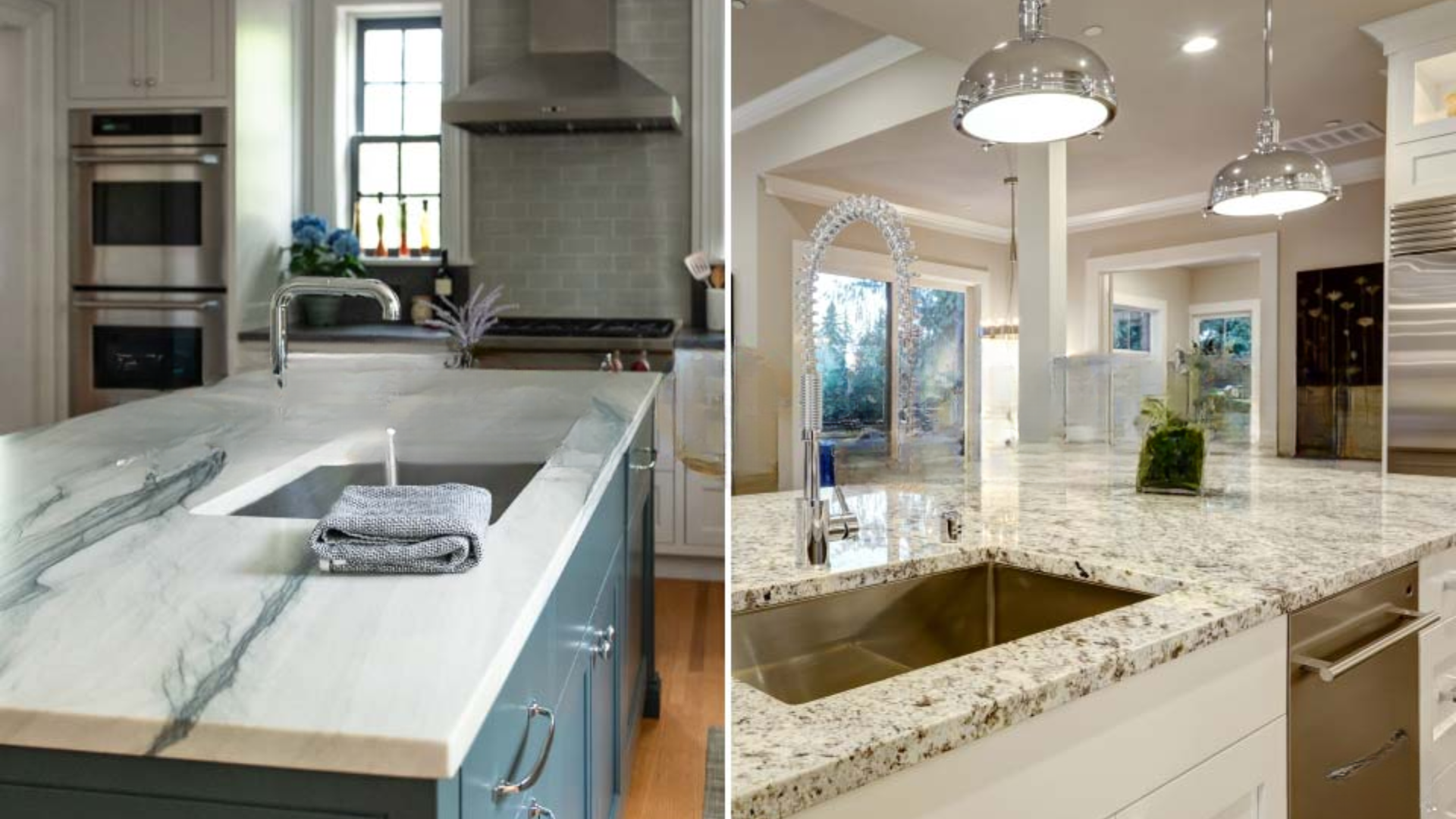
Cost, moisture safety, and heat resistance are important to consider when choosing between quartzite and granite. Here are the differences in price, water safety, and heat handling.
| Feature | Quartzite | Granite |
|---|---|---|
| Origin | Formed from sandstone and heated deep underground | Formed from slowly cooled molten rock (lava) underground |
| Appearance | Marble-like with soft, flowing patterns in pale colors | Speckled, grainy texture with bold, rich, and varied colors |
| Uniqueness | Each slab is unique, with natural veining | Each slab is unique, with bold color and mineral flecks |
| Hardness | Extremely hard; more scratch-resistant than granite | Very hard and durable; slightly less hard than quartzite |
| Heat Resistance | Good heat resistance, but safer to use trivets | Excellent heat resistance; can handle hot pans directly |
| Stain Resistance | Needs regular sealing to resist stains | Needs sealing; some types are naturally more stain-resistant |
| Moisture Resistance | Slightly more porous; requires yearly sealing | Less porous, especially in darker varieties; still needs sealing |
| Maintenance | Gentle cleaners only; seal yearly | Gentle cleaners; sealing depends on type (some may need less) |
| Ease of Cleaning | Easy with soap and water; avoid harsh chemicals | Easy with soap and water; avoid vinegar, bleach, or acids |
| Cost | Higher due to rarity and cutting difficulty | More budget-friendly and widely available |
Which Is Better?
The best choice depends on your needs, style, and how you use your space.
If you want a super-strong stone with a soft, elegant look, quartzite is the better choice. It gives you the beauty of marble but with added strength.
It’s a top pick if your home gets a lot of activity, especially in the kitchen, and you want something durable that still looks elegant.
Granite, on the other hand, is better if you’re looking for bold colors, fun patterns, and a more budget-friendly option.
It’s also slightly easier to maintain in some cases, and its heat resistance is top-notch, making it great for everyday cooking.
So, which is better? If strength and soft beauty are your top priorities, opt for quartzite. If budget, color variety, and bold design are key, granite is a smart choice.
Both are great stones; you just need to match one to your priorities.
Conclusion
Choosing between quartzite and granite isn’t easy, but it’s exciting. Both are beautiful, natural stones with their own strengths.
I love how quartzite provides a soft, marble-like appearance with added durability.
Granite, on the other hand, offers bold colors, classic patterns, and solid reliability, often at a more competitive price.
Consider how you utilize your kitchen or bathroom. Do you cook often? Do you lean toward calm colors or bold tones? Do you want something that feels elegant or more earthy and grounded?
From what I’ve seen, the best choice is the one that fits your lifestyle and taste. I try not to follow trends too closely, instead focusing on what makes my home feel good to live in.
Either way, quartzite or granite, you’ll get a surface that’s strong, stylish, and something to enjoy every single day.
Frequently Asked Questions
Is quartzite more expensive than granite?
Yes, quartzite is usually more expensive due to its strength, appearance, and the work required to cut it. Granite is more common and generally more budget-friendly.
Can you cut directly on quartzite or granite countertops?
You can, but it’s better to use a cutting board. Both stones are hard, but cutting can dull your knives and might scratch the surface over time.
Which one is easier to maintain?
Granite may be a little easier if you choose a dense type that doesn’t need sealing as often. But both are easy with regular care and simple cleaning.
Can I use quartzite or granite in the bathroom?
Yes, both are great for bathrooms. Just make sure to seal them well, especially quartzite, to protect against water and soap stains.


